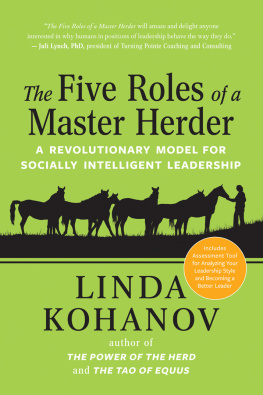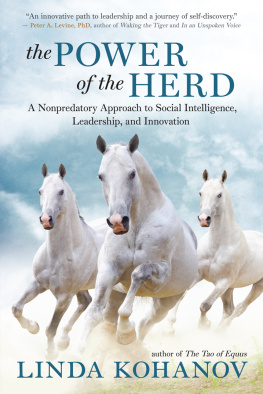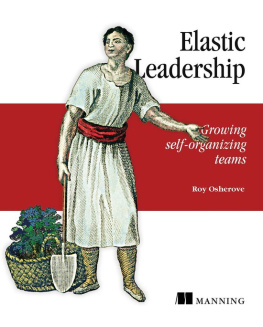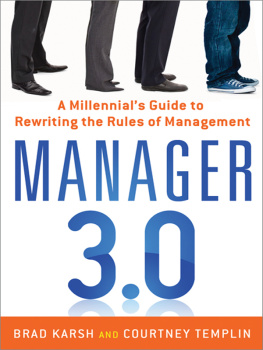
Also by Linda Kohanov
The Power of the Herd: A Nonpredatory Approach to Social Intelligence, Leadership, and Innovation
Riding between the Worlds: Expanding Our Potential through the Way of the Horse
The Tao of Equus: A Womans Journey of Healing and Transformation through the Way of the Horse
Way of the Horse: Equine Archetypes for Self-Discovery A Book of Exploration and 40 Cards


| New World Library 14 Pamaron Way Novato, California 94949 |
Copyright 2016 by Linda Kohanov
All rights reserved. This book may not be reproduced in whole or in part, stored in a retrieval system, or transmitted in any form or by any means electronic, mechanical, or other without written permission from the publisher, except by a reviewer, who may quote brief passages in a review.
Text design by Tona Pearce Myers
Library of Congress Cataloging-in-Publication Data
Names: Kohanov, Linda, author.
Title: The five roles of a master herder : a revolutionary model for socially intelligent leadership / Linda Kohanov.
Description: Novato, California : New World Library, 2016.
Identifiers: LCCN 2016006216 (print) | LCCN 2016013516 (ebook) | ISBN 9781608683383 (hardback) | ISBN 9781608683390 (ebook)
Subjects: LCSH: Social intelligence. | Leadership. | Organizational behavior. | BISAC: BUSINESS & ECONOMICS / Leadership. | NATURE / Animals / Horses. | SELF-HELP / Personal Growth / General. | SOCIAL SCIENCE / Anthropology / Cultural.
Classification: LCC HM1106 .K6175 2016 (print) | LCC HM1106 (ebook) | DDC 303.3/4dc23
LC record available at http://lccn.loc.gov/2016006216
First paperback printing, December 2017
ISBN 978-1-60868-546-2
Ebook ISBN 978-1-60868-547-9
Printed in Canada on 100% postconsumer-waste recycled paper

| New World Library is proud to be a Gold Certified Environmentally Responsible Publisher. Publisher certification awarded by Green Press Initiative. www.greenpressinitiative.org |
10 9 8 7 6 5 4 3 2 1
Contents
L earning to share power is the challenge of the twenty-first century.
Men and women of diverse educational and economic backgrounds can access information and resources that were unavailable to them a mere decade ago. Today, anyone with a great idea can raise money online, order supplies delivered to the door, and conceive a multi-million-dollar corporation in the corner of a basement or garage.
In our global culture, its not only journalists and politicians who disseminate information and share views. People around the world watch dramas as they unfold moment to moment, empathize, and join an international conversation that sometimes changes minds and lives.
As a result, command-and-control forms of leadership are suddenly less relevant and on their way to becoming impotent and, finally, obsolete.
Still, after five thousand years of hierarchical, conquest-oriented models, it takes time, imagination, and experimentation to change old patterns. Blocks to success arise daily when people lack the sophisticated interpersonal skills to collaborate with coworkers, employees, clients and family members, for that matter.
But were on the right track. In the last twenty years, much has been written about the importance of emotional and social intelligence , followed eighty-five PhD candidates in various scientific disciplines over a forty-year period. The results were surprising: High emotional intelligence (EQ) turned out to be four times more important in determining professional success than raw IQ and training.
As Bob Wall, author of Coaching for Emotional Intelligence and Working Relationships likes to say, ; EQ helps you win the game. Just as physical conditioning takes consistency and dedication, emotional fitness doesnt happen overnight. But theres another challenge that raises the stakes considerably: We are, as a species, charged with rewriting the playbook for a whole new era of egalitarian sports, and the rules are changing fast.
Glimpse
When I was promoted to a management position in the 1980s, there were no studies to legitimize what are still loosely, sometimes dismissively, referred to as soft skills. The term emotional intelligence didnt emerge until 1990. It took another six years for Daniel Goleman to publish his influential book Emotional Intelligence. His equally important titles Primal Leadership (with Richard Boyatzis and Annie McKee) and Social Intelligence: The New Science of Human Relationships werent released until 2002 and 2006, respectively. These and other books by authorities in the field have since sold millions of copies. Their popularity is a testament to something significant that went unnamed for far too long.
Its clear to me now, for instance, that a certain proficiency in emotional and social intelligence won me that first promotion to program director of a Florida public radio station. Three decades later, I asked my station manager, Pat Crawford, why he took a chance on me, a twenty-four-year-old classical music announcer. You didnt just get along with your colleagues, you supported them in developing their own talents and taking creative risks, he told me. You were out in the community, doing public presentations, making connections. You were constantly stretching yourself, encouraging others to stretch, and expanding awareness of the radio station in the process.
The backlash I initially endured over that promotion was significant. For the first two months, I ran a gauntlet of skeptical, sometimes-hostile reactions from staff members who tested me every chance they got. It was painful at times, but I became stronger. By standing my ground and refusing to hold grudges, I eventually won over the majority of my staff with an inclination to encourage and empower rather than rein in and ride herd over them. In this respect, our station manager and I were kindred spirits to a certain extent.
Though Pat preferred to motivate rather than intimidate, he had no qualms about wielding overt authority, unapologetically, if other tactics proved ineffective with certain people. I, on the other hand, avoided anything resembling dominance, in large part because I had seen it so profoundly misused. This occasionally resulted in my supervisor having to step in when my more congenial style wasnt enough to handle conflicts between coworkers and to get uncooperative employees back on track.
I now recognize Pats thoughtful, conservative use of the Dominant role as one of the marks of a mature, well-rounded leader. But it took me years to acknowledge the part this sometimes-dangerous power tool plays in the optimal functioning of any organization.
The Elephant in the Room
Over the next twenty years, I worked in nonprofit, corporate, freelance, entrepreneurial, and even therapeutic contexts, sometimes as a manager, sometimes as an employee taking an unofficial leadership role, and sometimes as a collaborator, educator, board member, or consultant. Over time, I began to see a pattern. Brilliant, well-meaning people who were technically accomplished in all kinds of fields had trouble getting along. While most said they felt stifled by traditional hierarchical structures, debilitating conflict all too often ensued when these same professionals were given free rein to question the status quo, experiment, and create something new with others.
Next page











